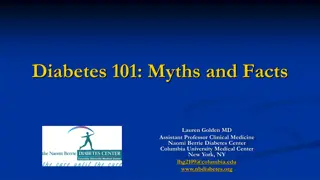Autoimmune Diseases in SLE and Type I Diabetes
Systemic Lupus Erythematosus, an autoimmune disease more common in women, affects various organs due to autoantibodies and immune complexes. The origin is unknown but involves antibodies against cell nucleus components. Type I Diabetes involves chronic destruction of insulin-producing cells in the pancreas, leading to high blood glucose levels and metabolic issues.
Download Presentation

Please find below an Image/Link to download the presentation.
The content on the website is provided AS IS for your information and personal use only. It may not be sold, licensed, or shared on other websites without obtaining consent from the author.If you encounter any issues during the download, it is possible that the publisher has removed the file from their server.
You are allowed to download the files provided on this website for personal or commercial use, subject to the condition that they are used lawfully. All files are the property of their respective owners.
The content on the website is provided AS IS for your information and personal use only. It may not be sold, licensed, or shared on other websites without obtaining consent from the author.
E N D
Presentation Transcript
AUTOIMMUNITY AND AUTOIMMUNE DISEASES Dr Dr. . Mayssaa Mayssaa Essam Essam
SYSTEMIC LUPUS ERYTHEMATOSUS (SLE SYSTEMIC LUPUS ERYTHEMATOSUS (SLE) ) Autoimmune disease that is more than nine times more common in women than in men, and three times more common in African Americans, and people of Asian. The disease gets its name (which literally means red wolf ) from a reddish rash on the cheeks ( malar ), a frequent early sign (Figure 1-3). The term systemic is quite appropriate, because the disease affects many organs of the body. It is mediated mostly by autoantibodies and immune complexes, which often deposit in the skin, joints, lungs, blood vessels, heart, kidney, and brain. Symptoms include: fever, skin rashes, joint pain, and damage to the central nervous system, heart, lungs, and kidneys. The destructive kidney lesions may lead to renal failure.
Figure (1-3) Typical reddish malar rash on the face of a young girl with SLE
The origin of this disease is still a mystery, but details of the immunologic mechanisms responsible for the pathology are partially known. Patients with SLE produce antibodies mostly against components of the cell nucleus (antinuclear antibodies [ANAs]), notably against native dsDNA. Antibodies may also be produced against denatured, single stranded DNA, ribonucleoproteins, and nucleohistones, . It is generally believed that nuclear autoantigens become available during the process of apoptosis.
Normally, The phagocyte system removes such potentially immunogenic autoantigens swiftly. There is evidence in human lupus that clearance of apoptotic cells is impaired, and disorders in the clearance of apoptotic cells give rise to a lupus-like syndrome in multiple animal models. Antibodies to single-stranded DNA are produced in normal individuals, but they are generally low-affinity IgM antibodies. However, isotype switching and somatic mutation can result in the production of high-affinity IgG antibodies to dsDNA, provided the B cells are given appropriate T-cell help. Along with dsDNA.
TYPE I DIABETES MELLITUS. Is a form of diabetes that involves chronic inflammatory destruction of the insulin-producing cells in the islets of Langerhans of the pancreas. The results in little or no insulin production. Insulin facilitates the entry of glucose into cells, where it is metabolized for energy production. signs & symptoms In the absence of insulin, levels of blood glucose rise, resulting in increased hunger, frequent urination, and excessive thirst. Other symptoms include weight loss, nausea, and fatigue. A major concern is the development of ketoacidosis, which lowers blood pH. This occurs when cells begin to break down proteins and fatty acids to meet metabolic demands in the absence of glucose. (TIDM)
InTIDM, the major contributors to -cell destruction are cytotoxic CD8+ T cells. However, inflammatory infiltrates in the islets of Langerhans include CD4+ T cells and macrophages, along with the cytokines they secrete, such as IL-1, IL-6, and IFN- . Many patients with TIDM also develop autoantibodies to insulin and other antigens such as glutamic acid decarboxylase (GAD). It is thought that these autoantibodies arise as a consequence of -cell destruction .Also genetic factors predisposing to TIDM include several genes in the HLA class II region, the insulin gene on chromosome 11.
RHEUMATOID RHEUMATOID Is an autoimmune disease that causes chronic inflammation of the joints ,women are more likely to be affected than men and usually strikes between the ages of 20 and 40. signs & symptoms Resulting in pain, swelling, stiffness, and deformity. Other symptoms include fatigue, low-grade fever, and loss of appetite. RA is characterized by chronically inflamed synovium (soft tissue that lines the joints). Densely crowded with lymphocytes, which results in the destruction of cartilage and bone. In RA the inflamed synovial membrane, usually one-cell thick, becomes so cellular that it mimics lymphoid tissue and forms new blood vessels. The synovium is densely packed with dendritic cells, macrophages, T and B cells, NK cells, and plasma cells. In some cases, the synovium develops secondary follicles. ARTHRITIS ARTHRITIS.( PROTEINS) .( PROTEINS) (RA) (RA)
The pathogenesis of RA is complex and involves T and B lymphocytes as well as macrophages. Most patients produce IgM antibody specific for a determinant on the Fc portion of IgGs. This anti-IgG antibody is called rheumatoid factor (RF). When RF binds to IgG, the resulting immune complexes can deposit in the joints, where the complement and establish an inflammatory process Joint damage is due to invasion of inflammatory cells such as neutrophils, and macrophages. Proliferation of fibroblast, macrophages and mast cells result in the formation of a pannus, an organized mass of cells that grow into the joint space.
THERAPEUTIC STRATEGIES THERAPEUTIC STRATEGIES Treatment of most autoimmune diseases remains largely empirical and nonspecific. Corticosteroids, which have potent suppressive effects on many of the cells involved in immune responses, are still widely used in various doses, depending on disease severity. Besides increasing susceptibility to infection, long-term use of corticosteroids puts patients at risk for a wide range of side effects, including hypertension, weight gain, glucose intolerance, skin fragility and impaired wound healing, and avascular necrosis of bone.
Serious autoimmune conditions, therapies with nonspecific effects on replicating cells continue to be used. These include the antimetabolite and antifolate agent methotrexate, DNA-alkylating drugs such as cyclophosphamide, and the purine analogue azathioprine. More specific suppression of the immune response can be achieved by using drugs such as cyclosporin A or FK506, which block intracellular signaling pathways mostly in T cells and prevent their activation.
Anticytokine therapies have proven very successful against several autoimmune diseases. Blockade of TNF- by monoclonal antibody or soluble receptor is an important therapeutic option in RA and inflammatory bowel disease. Inhibition of IL-1 by soluble receptor is of particular use in autoinflammatory disease and in Still s disease, a form of juvenile rheumatoid arthritis. Blocking antibody against the IL-6 receptor is effective in RA, and antibody against a subunit of the IL-12/IL-23 receptor has been approved for the treatment . These are but a few of the monoclonal antibodies in use or in development for autoimmune and inflammatory diseases.
REFRENCES - Oxford Handbook of Clinical Immunology and Allergy(Third edition-2013). Gavin P Spickett. - Immunology A Short Course (Seventh Edition- 2015).Richard Coico&Geoffrey Sunshine.
THANK YOU & GOOD LUCK























